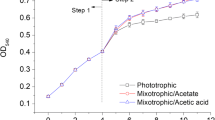Abstract
Production of astaxanthin by sequential heterotrophic-photoautotrophiccultivation of a green alga, Haematococcus pluvialis was investigated.This involved cultivating the cells heterotrophically to high cellconcentration, followed by illumination of the culture for astaxanthinaccumulation. The optimum pH and temperature for heterotrophic biomassproduction were 8 and 25 °C, respectively. There was no significantdifference in the specific growth rate of the cells when acetateconcentration was varied between 10 mM and 30 mM. However, cellgrowth was inhibited at higher acetate concentrations. A pH stat methodwas then used for fed-batch heterotrophic culture, using acetate as theorganic carbon source. A cell concentration of 7 g L-1 wasobtained. Higher cell concentration could not be obtained because the cellschanged from vegetative to cyst forms during the heterotrophic cultivation.However, by using repeated fed-batch processes, the cells could bemaintained in the vegetative form, leading to more than two times increasein cell number output rate. When the vegetative cells were transferred tophotoautotrophic phase, there was a sharp decrease in the cell number andonly very few cells encysted and accumulated astaxanthin. On the otherhand, when the shift from heterotrophic to photoautotrophic condition wasdone when most of the cells had encysted, there was still a decrease in cellnumber but astaxanthin accumulation was very high. The astaxanthinconcentration (114 mg L-1) and productivity (4.4 mg L-1d-1) obtained by this sequential heterotrophic-photoautotrophiccultivation method are very high compared to the data in the literature.
Similar content being viewed by others
References
Bon JA, Leathers TD, Jayaswal RK (1997) Isolation of astaxanthinoverproducing mutants of Phaffia rhodozyma. Biotechnol. Lett. 19: 109–112.
Borowitzka MA, Huisman JM, Osborn A (1991) Culture of the astaxanthin-producing green alga Haematococcus pluvialis, 1. Effects of nutrients on growth and cell type. J. appl. Phycol. 8: 15–19.
Chumpolkulwong N, Kakizono T, Nagai S, Nishio N (1997) Increased astaxanthin production by Phaffia rhodozyma mutants isolated as resistant to diphenylamine. J. Ferment. Bioengng 83: 429–434.
Cordero B, Otero A, Patino M, Arredondo BO, Fabregas J (1996) Astaxanthin production from the green alga Haematococcus pluvialis with different stress conditions. Biotechnol. Lett. 18: 213–218.
Fan L, Vonshak A, Gabbay R, Hirshberg J, Cohen Z, Boussiba S (1995) The biosynthetic pathway of astaxanthin in a green alga Haematococcus pluvialis as indicated by inhibition with diphenylamine. Plant Cell Physiol. 36: 1519–1524.
Gong X, Chen F (1997) Optimization of culture medium for growth of Haematococcus pluvialis. J. appl. Phycol. 9: 437–444.
Harker M, Tsavalos AJ, Young AJ (1996) Autotrophic growth and carotenoid production of Haematococcus pluvialis in a 30 liter air-lift photobioreactor. J. Ferment. Bioengng. 82: 113–118.
Kobayashi M, Kakizono T, Yamaguchi K, Nishio N, Nagai S (1992) Growth and astaxanthin formation of Haematococcus pluvialis in heterotrophic and mixotrophic conditions. J. Ferment. Bioengng 74: 17–20.
Kobayashi M, Kurimura Y, Tsuji Y (1997) Light-independent astaxanthin production by the green microalga Haematococcus pluvialis under salt stress. Biotechnol. Lett. 19: 507–509.
Miki W (1991) Biological functions and activities of animal carotenoids. Pure Appl. Chem. 63: 141–146.
Moya MJ, Sanchez-Guardamino ML, Vilavella A, Barbera E (1997) Growth of Haematococcus lacustris: A contribution to kinetic modelling. J. Chem. Tech. Biotechnol. 68: 303–309.
Ogbonna JC, Masui H, Tanaka H (1997) Sequential heterotrophic/autotrophic cultivation-An efficient method of producing Chlorella biomass for health food and animal feed. J. appl. Phycol. 9: 359–366.
Ogbonna JC, Tomiyama S, Tanaka H (1999) Production of atocopherol by sequential heterotrophic-photoautotrophic cultivation of Euglena gracilis. J. Biotechnol. 70: 213–221.
Olaizola M (2000) Commercial production of astaxanthin from Haematococcus pluvialis using 25,000–liter outdoor photobioreactors. J. appl. Phycol. 12: 499–506.
Parker RE (1980) Introductory statistics for biology. Second edition, Edward Arnold Publishers Ltd. pp. 12–16, 60–73.
Pringsheim EG (1966) Nutritional requirements of Haematococcus pluvialis and related species. J. Phycol. 2: 1–7.
Tjahjono AE, Hayama Y, Kakizono T, Terada Y, Nishio N, Nagai S (1994) Hyper-accumulation of astaxanthin in a green alga Haematococcus pluvialis at elevated temperatures. Biotechnol. Lett. 16: 133–138.
Yokoi H, Koga J, Yamamura K, Seike Y, Tanaka, H (1993) High density cultivation of plant cells in a new aeration-agitation type fermentor, Maxblend Fermentor. J. Ferment. Bioengng 75: 48–52.
Author information
Authors and Affiliations
Rights and permissions
About this article
Cite this article
Hata, N., Ogbonna, J.C., Hasegawa, Y. et al. Production of astaxanthin by Haematococcus pluvialis in a sequential heterotrophic-photoautotrophic culture. Journal of Applied Phycology 13, 395–402 (2001). https://doi.org/10.1023/A:1011921329568
Issue Date:
DOI: https://doi.org/10.1023/A:1011921329568




